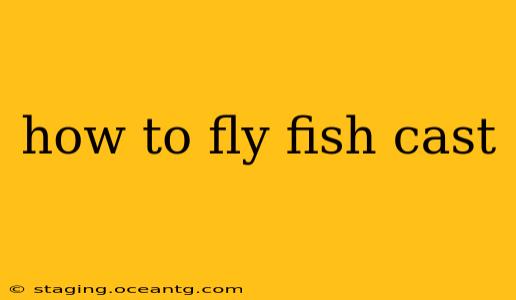Fly fishing casting is a skill that takes time and practice to master, but the rewards are immense. The graceful arc of the line, the satisfying thwack as it lands on the water, and the thrill of the catch all contribute to the allure of this challenging yet rewarding sport. This comprehensive guide will break down the fundamental techniques, helping you confidently cast your fly line.
Understanding the Basic Fly Fishing Cast
Before diving into the mechanics, it's crucial to understand the principles behind a successful cast. The goal is to deliver your fly to a target with accuracy and delicacy, minimizing disturbance to the water's surface. This involves a coordinated movement of your rod, line, and body, creating a smooth, efficient energy transfer.
The Components of a Fly Cast:
- The Backcast: This is the initial movement, sending the line behind you. A good backcast is the foundation of a good forward cast.
- The Pause: A brief pause at the end of the backcast allows the line to straighten and load the rod. This is critical for generating power and accuracy.
- The Forward Cast: This is the power stroke, propelling the line forward to your target.
- The Stop: A firm stop at the end of the forward cast prevents the line from collapsing and ensures accuracy.
How to Perform a Basic Overhead Cast: A Step-by-Step Guide
-
Grip: Hold the rod comfortably, but firmly, with your dominant hand. Avoid gripping too tightly, as this can restrict your casting motion.
-
Stance: Stand with your feet shoulder-width apart, facing your target. A comfortable stance will help with balance and fluidity.
-
The Backcast: Lift the rod smoothly, keeping your arm close to your body. Bring the rod back in a controlled arc, stopping just behind you. Your arm should remain relatively straight throughout the movement; avoid any abrupt stops or jerks. Visualize a smooth, even loop forming behind you.
-
The Pause: Pause for a split second at the end of your backcast. This allows the line to straighten out and load the rod, storing energy for the forward cast. This is a subtle pause; avoid excessive delays.
-
The Forward Cast: Using a smooth, controlled motion, bring the rod forward, following the same arc as the backcast. As the rod moves, accelerate gradually and stop at the end. The transfer of energy is key here; avoid forcefully jerking the rod.
-
The Stop: A firm stop is crucial. This prevents the line from collapsing, keeping the loop tight and your cast accurate.
-
Practice: Consistent practice is key. Start with short casts, gradually increasing the distance as your technique improves.
Common Fly Fishing Casting Mistakes
Many beginners struggle with these common issues:
- Lifting the rod too high: This can lead to slack line and inaccurate casts. Keep the rod tip relatively low, allowing the line to unroll smoothly.
- Not pausing: The pause between the backcast and forward cast is vital for energy transfer. Neglecting this can result in weak, inaccurate casts.
- Jerky movements: Smooth, controlled movements are key. Avoid jerky motions, which will only lead to tangles and poor results.
- Gripping too tightly: A relaxed grip allows for smoother rod movement.
Different Fly Casting Techniques
While the overhead cast is a fundamental technique, experienced fly fishers employ various casting styles depending on the circumstances. These include:
- The Roll Cast: Used in tight spaces where a backcast isn't feasible.
- The Spey Cast: A powerful double-handed cast used for larger flies and longer distances.
- The Curve Cast: Employed to cast around obstacles.
Frequently Asked Questions (FAQs)
What type of fly rod should I use for learning?
A 9-foot, 5-weight fly rod is a good starting point for beginners. It offers a good balance of power and flexibility.
How long does it take to learn to fly cast?
It takes time and dedication. Some learn the basics relatively quickly, while others may take longer. Consistent practice is key.
What kind of line should I use?
A weight-forward fly line is recommended for beginners. It helps load the rod effectively and facilitates easier casting.
How do I prevent tangles?
Careful attention to the casting technique and keeping the line straight are vital. Practice short casts initially to improve your technique before attempting longer casts.
Mastering the fly cast is a journey, not a destination. With patience, practice, and a willingness to learn, you'll be able to enjoy the many rewards this challenging yet rewarding sport has to offer. Remember to embrace the process, celebrate small victories, and enjoy the beauty of the outdoors!
